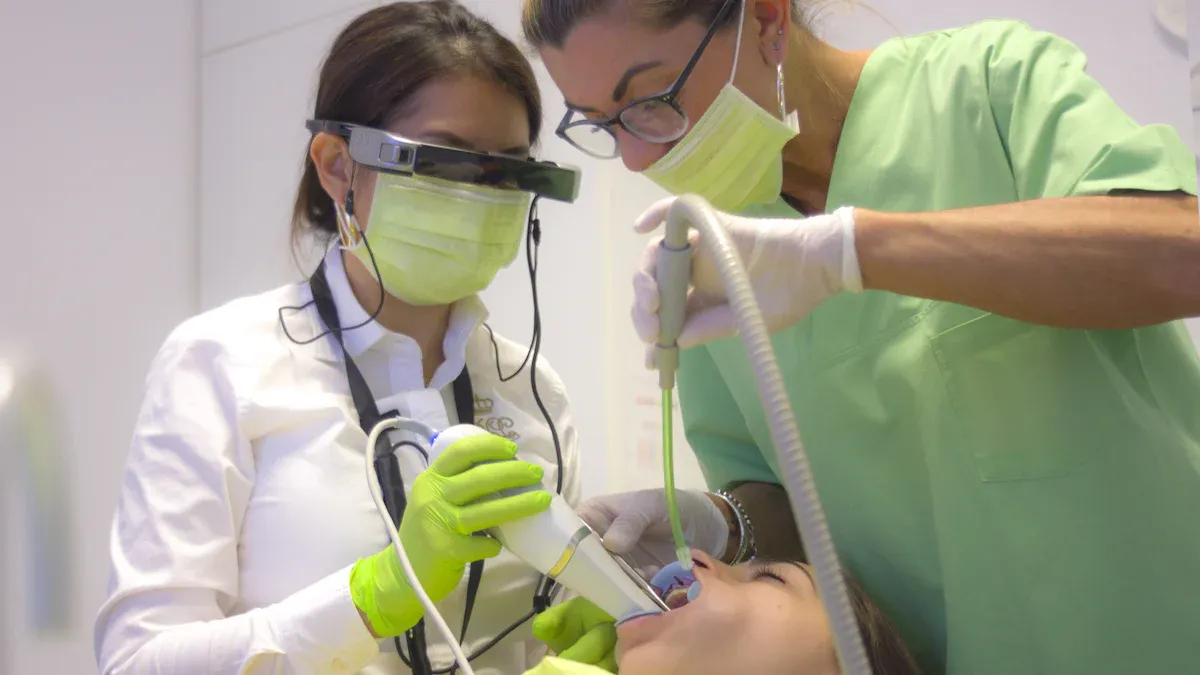Image Source: pexels
Medical malpractice cases affect thousands of lives each year. On average, 85,000 cases are filed annually in the United States, with over 1.41 million cases recorded in the past 30 years. These cases often erode trust between patients and healthcare providers. A single error can cause emotional distress, leaving patients fearful of future medical care. Accountability within the healthcare system plays a critical role in restoring confidence and preventing further harm. Understanding the analysis of successful medical malpractice cases and compensation standards helps address these challenges effectively.
Key Takeaways
- Medical malpractice happens when a doctor makes a harmful mistake.
- To win, patients must show duty, mistake, harm, and loss.
- Clear communication and good record-keeping help doctors avoid lawsuits.
Defining Medical Malpractice and Key Elements of a Successful Case
What Is Medical Malpractice?
Medical malpractice occurs when a healthcare provider fails to meet the expected standard of care, resulting in harm to the patient. I often explain this concept by focusing on the relationship between the provider’s actions and the patient’s injury. For a case to qualify as malpractice, the provider must have acted negligently, and this negligence must have directly caused harm.
Common examples of malpractice include surgical errors, misdiagnoses, and medication mistakes. For instance, performing surgery on the wrong body part or prescribing the wrong medication can have devastating consequences. These breaches highlight the importance of adhering to established medical standards.
The Four Elements: Duty, Breach, Causation, and Damages
To succeed in a medical malpractice case, the injured patient must prove four critical elements:
- The healthcare provider owed a duty of care to the patient.
- The provider breached this duty.
- The breach directly caused harm to the patient.
- The harm resulted in specific damages, such as medical expenses or emotional suffering.
The injured patient must show that the physician acted negligently in rendering care, and that such negligence resulted in injury. To do so, four legal elements must be proven: (1) a professional duty owed to the patient; (2) breach of such duty; (3) injury caused by the breach; and (4) resulting damages.
These elements form the foundation of any malpractice claim. Without them, it becomes nearly impossible to establish liability.
The Role of the Medical Standard of Care
The medical standard of care serves as the benchmark for evaluating a provider’s actions. I view it as the level of care that a reasonably competent professional would provide under similar circumstances. When a provider deviates from this standard, it often leads to errors such as misdiagnoses, surgical mistakes, or failure to obtain informed consent.
For example, insufficient monitoring after surgery can result in undetected complications. Similarly, poor hygiene practices may lead to hospital-acquired infections. These breaches emphasize the need for strict adherence to the standard of care to prevent harm and ensure patient safety.
Factors Behind Successful Medical Malpractice Cases

Image Source: unsplash
Patient Demographics and Their Influence
I’ve observed that patient demographics can significantly influence the outcomes of medical malpractice cases. Factors such as age, gender, and socioeconomic status often play a role in how claims are perceived and resolved. For instance, cases involving children or elderly patients tend to evoke stronger emotional responses, which may impact jury decisions. Additionally, patients from underserved communities may face unique challenges in proving their claims due to limited access to resources or medical records.
Severity of Injury and Its Impact on Case Outcomes
The severity of the injury is another critical factor in determining the success of a malpractice case. Serious injuries, such as permanent disability or wrongful death, often result in higher compensation. I’ve noticed that cases involving harm from unsafe conditions or egregious medical errors tend to be more compelling. For example:
- Harm caused by poor treatment.
- Illness due to unsanitary conditions.
- Severe errors by healthcare professionals.
These cases highlight the importance of demonstrating measurable damages, such as medical expenses or lost wages, to strengthen a claim.
Common Physician Errors That Lead to Claims
Certain physician errors frequently lead to malpractice claims. Based on my experience, the most common include:
- Misdiagnosis or delayed diagnosis.
- Surgical or anesthesia errors.
- Medication mistakes.
- Birth injuries.
Each of these errors reflects a breach of the medical standard of care, which is central to proving negligence. For example, a delayed diagnosis of cancer can result in missed treatment opportunities, causing irreversible harm.
The Importance of Expert Testimony in Proving Negligence
Expert testimony often serves as the cornerstone of a successful malpractice case. Medical experts help establish the standard of care and explain how the provider’s actions deviated from it. Their insights clarify complex medical concepts, enabling judges and juries to make informed decisions. I’ve seen how a credible expert can decisively prove negligence by linking the breach of care to the patient’s injury. For defendants, experts can challenge claims and offer alternative explanations, which underscores the importance of selecting qualified witnesses.
Analysis of Compensation Standards in Medical Malpractice Cases

Image Source: unsplash
Average Payouts and Trends in Compensation
I’ve noticed that compensation in medical malpractice cases varies widely based on the severity of the injury. For example:
- Minor permanent injuries average $260,865.
- Significant permanent injuries average $619,010.
- Grave permanent injuries can reach $2,428,366.
The average settlement across all cases in the U.S. is $348,065, with 96.5% of cases ending in settlements. Over the past 30 years, the national average award per case has been $101,716. However, recent trends show a decline, with the average award in 2019 dropping to $75,380. These figures highlight the importance of understanding how injury severity impacts compensation.
State-by-State Variations in Compensation Standards
Compensation standards differ significantly across states due to factors like damage caps and legal requirements. For instance:
- Arkansas imposes no limits on compensation.
- California caps non-economic damages at $250,000.
- New York, which has no cap, reported $434 million in liabilities in 2022.
States like Texas and California restrict non-economic damages, while others, such as Pennsylvania, allow higher payouts. These variations emphasize the need to consider jurisdiction when pursuing a malpractice claim.
Economic vs. Non-Economic Damages: Key Differences
Compensation in malpractice cases typically falls into two categories:
| Type of Damages | Examples |
|---|---|
| Economic Damages | Medical expenses, Future medical expenses, Lost income |
| Non-Economic Damages | Pain and suffering, Loss of enjoyment/quality of life |
Economic damages cover measurable financial losses, while non-economic damages address intangible harm. Both play a critical role in determining total compensation.
Caps on Damages and Their Legal Implications
Many states impose caps on damages, particularly non-economic ones. These caps limit the compensation injured patients can receive, even if they win their case. For example, California’s $250,000 cap on non-economic damages often influences settlement negotiations. Defendants may risk going to trial, knowing the potential payout is limited. While economic damages remain uncapped in most states, these restrictions can significantly impact the final award.
Ethical and Legal Considerations in Medical Malpractice
Recent Changes in Legal Standards and Their Effects
Recent updates to legal standards have reshaped how medical malpractice cases are evaluated. I’ve observed that these changes aim to prioritize patient safety and accountability. For example:
- New informed consent standards now require healthcare providers to disclose more information and ensure patients fully understand their options.
- Patient safety legislation mandates the reporting of medical errors and promotes transparency through hospital safety scores.
- Stricter qualifications for expert witnesses limit the use of out-of-state experts, ensuring testimony aligns with local medical practices.
In 2024, the American Law Institute introduced a patient-centered approach to assessing medical negligence. This shift emphasizes reasonable care based on contemporary evidence and practices. I believe this change could significantly influence how courts determine negligence, making it more reflective of modern healthcare standards.
Balancing Patient Rights with Provider Protections
Balancing the rights of patients with the protections of healthcare providers remains a delicate challenge. Patients deserve accountability when harmed by negligence, but providers also need safeguards against frivolous lawsuits. I’ve found that clear legal frameworks help achieve this balance. For instance, damage caps in some states protect providers from excessive financial liability, while still allowing patients to recover economic damages. Additionally, mandatory error reporting fosters transparency without automatically assigning blame, encouraging providers to improve care without fear of litigation.
The Role of Compassion, Communication, Competence, and Charting
I’ve seen how compassion, communication, competence, and charting play a pivotal role in preventing malpractice claims:
- Compassion: Empathy strengthens patient relationships and reduces the likelihood of lawsuits.
- Communication: Clear explanations of diagnoses and treatments build trust and satisfaction.
- Competence: Continuous education ensures providers maintain high standards of care.
- Charting: Accurate documentation protects providers during legal disputes and supports their defense.
These elements not only enhance patient care but also minimize the risk of legal challenges.
Actionable Insights for Patients and Healthcare Providers
Risk Mitigation Strategies for Healthcare Providers
I’ve found that healthcare providers can reduce the risk of malpractice claims by adopting proactive strategies. Open communication with patients plays a vital role in building trust and minimizing misunderstandings. For example, explaining diagnoses and treatment plans clearly helps patients feel informed and valued.
Meticulous documentation is another essential practice. Accurate records of patient interactions and treatment decisions not only support effective care but also provide critical evidence in case of legal scrutiny. I always emphasize the importance of maintaining detailed notes to demonstrate adherence to the standard of care.
Here are some additional strategies I recommend:
- Foster clear and compassionate communication.
- Adhere strictly to the standard of care.
- Ensure thorough documentation.
- Stay informed through continuous education.
- Implement a proactive risk management strategy.
- Invest in quality liability insurance.
These steps create a strong foundation for reducing errors and protecting both patients and providers.
Navigating the Legal Process: Advice for Patients
Patients pursuing a medical malpractice claim often feel overwhelmed. I advise breaking the process into manageable steps:
- Schedule an initial consultation with an experienced attorney to evaluate your claim.
- Provide a notice of intent to the healthcare provider, signaling your intention to take legal action.
- Work with your attorney to draft a formal complaint outlining your allegations and injuries.
- Deliver the complaint to the defendant(s) through the service of process.
Each step ensures that your case progresses smoothly while protecting your rights.
The Importance of Professional Guidance in Malpractice Cases
Professional guidance is invaluable in navigating the complexities of medical malpractice cases. Attorneys and medical experts bring specialized knowledge that strengthens your claim. I’ve seen how their expertise clarifies legal and medical issues, ensuring fair outcomes for patients and providers alike.
Understanding the factors behind successful medical malpractice cases and compensation standards is crucial for both patients and healthcare providers. It ensures accountability and promotes better outcomes. Patients can protect their rights, while providers can improve care quality and reduce risks.
| Key Takeaway | Description |
|---|---|
| Duty of Care | Recognizing the obligation medical professionals have towards their patients. |
| Proving Negligence | Demonstrating that a breach of duty caused harm to the patient. |
| Meticulous Case Preparation | Highlighting the need for thorough preparation, starting with consultations. |
I encourage patients and providers to seek professional advice and make informed decisions. Together, we can foster a balanced, ethical healthcare system that prioritizes safety and trust.
FAQ
What is the statute of limitations for filing a medical malpractice case?
The statute of limitations varies by state. Most states allow 1-3 years from the date of injury or discovery of harm.
How can I determine if my case qualifies as medical malpractice?
I recommend consulting an experienced attorney. They can evaluate if negligence occurred and if it directly caused your injury or damages.
Do all medical malpractice cases go to trial?
No, most cases settle out of court. In fact, 96.5% of medical malpractice claims resolve through settlements rather than trials.
Tip: Early legal consultation increases the likelihood of a favorable settlement.




